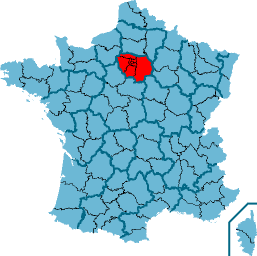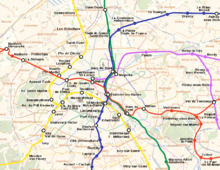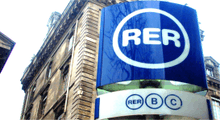Île-de-France
Île-de-France is the compact region immediately surrounding Paris. As such, the region includes all of the metropolis, from the great French capital itself through the gritty banlieue right out to now far-flung suburbs and exurbs, together with several large surrounding towns that form part of the greater conurbation. All is not urban sprawl, however: the region is also known for its natural beauty, in the form of parks, forests and river lands, and also contains some of the most fertile agricultural soil in France.


Understand
The name "Île-de-France" translates as "island of France", and though this etymology is unclear, it is thought to refer to the land between the rivers Seine, Marne and Oise, a sort of pseudo-"island" at the heart of France in a historical and cultural, if not geographic, sense. The north-east of the region is equally known as the Pays de France, which is essentially an agricultural terroir known for its cereal crops, though much of it has been overtaken by suburban sprawl and Charles de Gaulle Airport.
Île-de-France is easily the richest part of France, and is also one of Europe's most economically active regions. The majority of the region's inhabitants (who are known as Franciliens and Franciliennes), live and work somewhere in the dense Paris conurbation, leaving much of the rest of the territory rural and sparsely-populated.
From the traveller's perspective, most of the region's interest will of course lie in Paris's mere 105 km², and it is true that the City of Lights is a shining beacon among the world's great metropolises. Paris's icons are French icons, and many will struggle to even bring France to mind without thinking of the Eiffel Tower, of mimes working the streets of Montmartre, of Gothic Métropolitain signs, or of Haussmannian boulevards lined with chic cafés and fashion stores. So this guide won't try to persuade you to skip Paris; you absolutely must go there! But if you do decide to venture beyond the Boulevard Périphérique, you will be richly rewarded.
Île-de-France's countryside is prosperous and agricultural. Dominated by its three major rivers, well-heeled market towns-cum-dormitory communities, and great châteaux from times gone by, it is a beautiful slice of rural France without having to stray far from the big city. The east of the region, the department of Seine-et-Marne, is especially lovely and forms part of the Champagne-growing area.
And who could forget Disneyland Paris, Europe's most popular visitor attraction? For anyone who knows Disney's American parks, paying a visit to "Chez Mickey" - as the place is blithely known by the locals - will be at once familiar and bizarrely different. Seeing the pink château de Cendrillon against a moody northern French sky, rather than say Californian azure, is enough to make anyone think to herself "Ah, le monde est petit !" (It's a small world after all).
Cities and towns
- 🌍 Paris – the capital of France and focus of the region is on every traveller's wishlist, even the ones who have already been!
- 🌍 Bobigny
- 🌍 Boulogne-Billancourt – one of Paris's nicer suburbs, at the tip of a peninsula carved by the snakelike Seine
- 🌍 Châteaufort
- 🌍 Eragny
- 🌍 Fontainebleau – to the south of the metropolis lies a vast forested estate, known for its opulent château and wonderfully fresh air
- 🌍 Le Bourget – hosts the biannual Paris Air Show, and France's main state-owned aviation museum
- 🌍 Levallois-Perret – perhaps Paris's wealthiest suburb, and in architecture, atmosphere and layout, very much an extension of the city. Together with neighbouring communes (Clichy and Neuilly-sur-Seine), Levallois has a large accommodation base at a slightly cheaper going rate than Paris "intra muros", without compromising on distance from attractions and the essential feel of being in Paris
- 🌍 Marne-la-Vallée – a large new town in Seine-et-Marne, best known for Mickey Mouse's European pad.
- 🌍 Meaux – a large new town in Seine-et-Marne, best known for Mickey Mouse's European pad.
- 🌍 Nogent-sur-Marne – riverside residential town famous for its guinguettes - restaurants and bars lining the river Marne
- 🌍 Provins – UNESCO listed fortified city in Île-de-France's rural heartland
- 🌍 Roissy – A historic city just outside its gates of Paris Charles de Gaulle Airport. It retains its small-town charm, and has several points of interest if you're staying near the airport overnight, or just have a long layover.
- 🌍 Rueil-Malmaison – a town in the outer western suburbs of Paris, home to a château and domaine that offer a similar experience to Versailles and Fontainebleau, but much cheaper, far less crowded and correspondingly more low-key
- 🌍 Saint-Denis – Somewhat rough-around-the edges northern Paris suburb, Saint-Denis nonetheless welcomes droves of visitors to its basilica, and to the Stade de France, France's national stadium
- 🌍 Versailles – 30 minutes west of Paris on the train, and above all prized for Louis XIV's incomparable château, which set the gold-standard for palace-dwellers the world over, and still continues to thrill, enchant and, depending on the crowds, exasperate millions of travellers to this day. Don't miss the majestic formal gardens and estate, Marie Antoinette's "summer house", which is really another palace in its own right, and the city of Versailles itself, which retains a smugly aristocratic elegance two centuries after its last king and queen lost their throne (and their heads).
Other destinations
- 🌍 Disneyland Paris – the European version of the quintessential American theme park is the antithesis of everything French and Parisian, but is year-on-year the continent's most visited tourist attraction. Notre Dame, the Louvre, the Eiffel Tower? Never heard of 'em!
Get in
By plane
By train
Seven main stations are located in Paris, and most of them welcome trains from bordering countries. They are connected through the métro and RER system only (no special shuttle).
- Gare du Nord, (10th), Métro: Gare du Nord - TGV trains to and from Belgium, the Netherlands, west Germany (Aachen, Cologne, Düsseldorf, Duisburg, Essen) (Thalys), and the United Kingdom (Eurostar from London and Kent) and regular trains from Hauts-de-France.
- Gare d'Austerlitz, (13th), Métro: Gare d'Austerlitz - regular trains to and from the center and southwest of France (Orléans, Limoges, Toulouse the long way) and the majority of night trains.
- Gare de l'Est, (10th), Métro: Gare de l'Est - TGV to and from Luxembourg, ICE/TGV to and from south Germany (Saarbrücken, Kaiserslautern, Mannheim, Frankfurt, Karlsruhe, Stuttgart, Augsburg, and Munich), RZD night train to and from Russia (Moscow), Belarus (Minsk), Poland (Warsaw, Poznan) and Germany (Berlin, Erfurt).
- Gare de Lyon, (12th), Métro: Gare de Lyon - regular and TGV trains to and from southern and eastern France: French Alps, Marseille, Lyon, Dijon, Switzerland (Basel, Geneva, Lausanne, Bern, Zurich) and southwest Germany (Müllheim, Freiburg im Breisgau). You can also catch day (Turin, Milan) and overnight trains (Milan, Verona, Padua, Venice) from and to Italy.
- Gare de Bercy, (12th), Métro: Bercy. Regular trains to Auvergne and Burgundy.
- Gare St Lazare, (8th) Métro: St-Lazare - trains to and from Basse-Normandie, Haute-Normandie.
- Gare Montparnasse, (15th), Métro: Montparnasse-Bienvenüe - TGV and regular trains to and from the west and south-west of France (Tours, Brest, Rennes, Nantes, Bordeaux, Toulouse the fastest way and Irún in Spain). Gare Vaugirard is an extension of Gare Montparnasse.
There are also three peripheral stations located on the outskirts of the Paris conurbation which welcome national and some international high speed trains:
- Gare Aéroport Charles de Gaulle 2 TGV, Paris CDG Airport, RER: Line B - Welcomes TGV trains from all over France and Belgium, all of which avoid central Paris. Helpful if you're visiting northern Île-de-France.
- Gare de Marne-la-Vallée — Chessy, Marne-la-Vallée, RER: Line A - Adjacent to Disneyland Paris, this receives TGVs travelling across France avoiding Paris, mainly on a northeast - southwest (e.g. Strasbourg to Bordeaux) or north to southeast (e.g. Lille to Lyon) route. This is the main hub of the SNCF's low-cost TGV service Ouigo, and there is also one Eurostar train a day to and from Lille, Ashford, Ebbsfleet and London. Helpful if you're visiting eastern Île-de-France.
- 🌍 Gare de Massy TGV (Massy, roughly 14 km south of Paris (Porte d'Orléans), RER (Massy — Palaiseau): Lines B, C). On the LGV Atlantique line which links Paris Montparnasse and eastern / northern France to the west and south west. Helpful if you're visiting southern or western Île-de-France.
Get around


By bike
There are many cycle lanes on routes into Paris, but be careful as you also share the road with motorists who can be inconsiderate.
By car
There are several free autoroutes and 4 lane roads for getting round Île-de-France, however on weekdays there is a lot of congestion between the hours 08:00-09:30 and 17:30-19:30, and it is really not advisable to travel then. This congestion becomes a lot less worse the further away from Paris you are.
- Le Boulevard Périphérique: a ring road which marks the limit of "Paris intra muros" (essentially the central city as distinct from its suburbs). This is essentially a motorway as there are no roundabouts or intersections, however it is famous for its traffic jams. Be careful though, as the cars entering onto the road from the right have priority over vehicles already on the Périphérique.
- A13 : (direction Rouen) Western Autoroute
- A6 : (direction Lyon) Southern Autoroute
- A5 : (direction Lyon) South eastern Autoroute
- A86 : Very useful road that nearly completely circles Paris. The recently opened tunnel between Rueil-Malmaison and Versailles is tolled (fairly expensive) and is open to cars only (trucks and motorcycles prohibited).
- A14 : Toll road, fairly expensive.
- N104 La Francilienne: A half circular road around the eastern side of Paris. As it is further out than the A86, there is considerably less congestion.
- N118 : Connect western Paris to A10 and N104.
By train
A network of regional trains (RER) takes you in and out of Paris. The RER has 256 stops in and around Paris, and runs on over 587 km (365 mi) of track. There are 5 lines, (A, B, C, D and E) that cross Paris, connecting suburbs on opposite sides. The stations are marked with blue signs with a white RER. The rest of the regional network, called "Transilien", departs from the main train stations (Lyon for line R, Est for line P, Nord for lines H and K, St-Lazare for lines J and L, Montparnasse for line N) and La Défense (line U). Trains can run up to every 5 minutes during rush hour, and you will never have to wait for more than 1 hour between two trains, even on the least served lines in the evening or on the weekend.
Tickets are only valid for the trip purchased, while passes use a 5-zone system. It may be cheaper for long trips on the regional network to purchase a daily ticket than a return ticket: a round-trip ticket from Paris to Provins costs €22.70, while a day pass (Mobilis) valid for zones 1-5 only costs €16.60. Check when purchasing, timetables, fare information, and maps for both systems can be found in on the English version of the Transilien website.
Trains run from 04:45 to 01:30. Smoking is not allowed in the stations or on the trains.
See
- Provins — a world heritage listed town about 50km east of Paris famous for its medieval heritage
- Poissy, southwest of Paris features Villa Savoye by Le Corbusier, one of the best known creations of this architect. It is one of 17 of his buildings worldwide that have been inscribed on the world heritage list. In Paris you can find three more of them : Villa La Roche, Villa Jeanneret and Immeuble Molitor.
- Versailles, a wealthy town in the Yvelines, where the most famous French palace and its gardens are located.
Do
- Le Musée Fragonard (L'Ecole Nationale Vétérinaire), 7, Avenue du Général de Gaulle (Métro: line 8 (Balard - Créteil) - Station: École Vétérinaire de Maisons-Alfort), ☎ +33 1 43 96 71 72. Closed in Aug; W-Th, 14:00-18:00; Sa-Su, 13:00-18:00. This is a hidden gem. A veterinary museum that doubles as natural history museum. A lot of medical oddities, mostly of animals, but also include real human specimens. Move over Bodyworlds, this museum holds Fragonard's original human preservation (wax- not plastic) including the famous "horseman of the apocalypse." Adults €7.